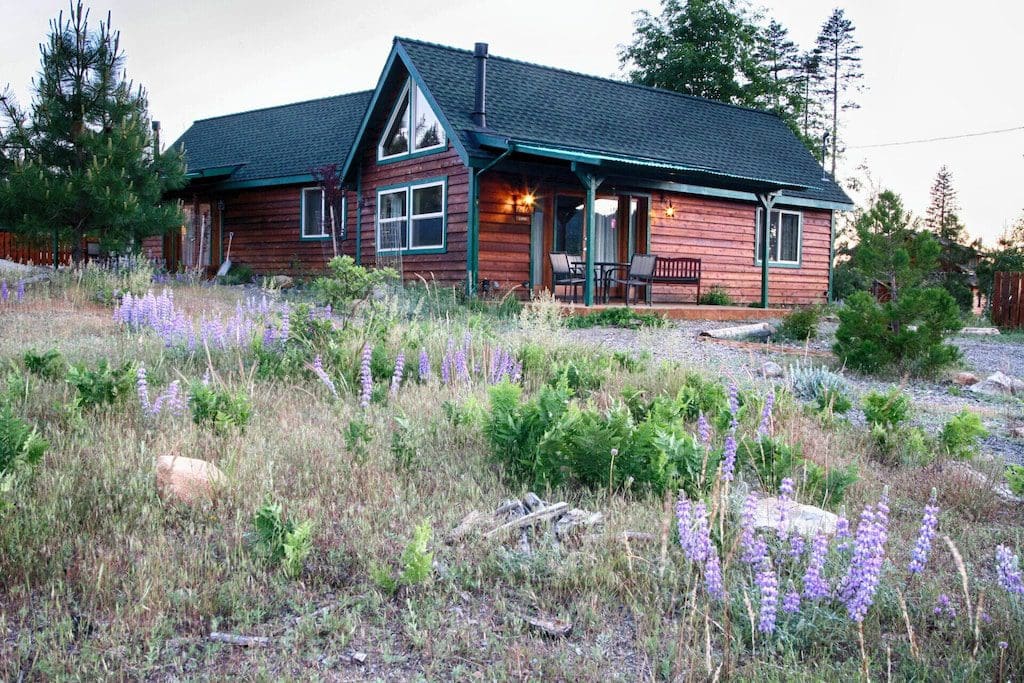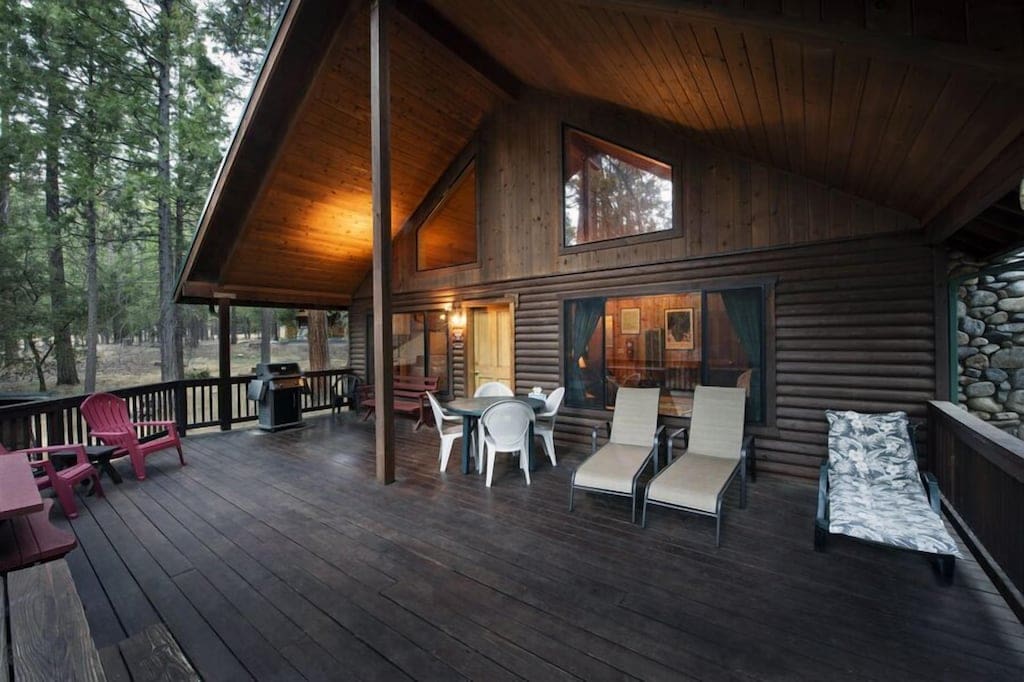|
Getting your Trinity Audio player ready...
|
Established in 1890
At the mention of Yosemite, the mind immediately travels to towering mountains, a rainbow of wildflowers, crystalline lakes, thunderous waterfalls, and, of course, those majestic sequoias. This is exactly what one finds at the second oldest national park in existence.
Overview
If Yosemite National Park isn’t on your bucket list, it should be. Here’s all the reasons you should see it, and some tips on how to get out into it!
From famous writings by famous writers to famous climbs by famous rock climbers, Yosemite is probably the most talked-about National Park on Earth. It’s widely celebrated for the stark beauty of its towering granite walls, its alpine meadows humming with life, and its silent forests of gigantic trees. The Yosemite Valley is so famously beautiful that most people who know it refer to it simply as “The Valley,” as if by comparison, any other mountain valley wasn’t worthy of the title.
But is it all just talk? What’s so special about big white cliffs and mountains, anyway? It’s hard to capture the pristine natural wonder of a place in words. But it’s our job, and we’re going to try anyway. That’s why we put together this guide, to convince you why Yosemite National Park has a place on your bucket list, and to give you the information you need to know to actually go see it. In short, here are the “whys” and “hows” to get you out the door and into one of the world’s most magnificent places.
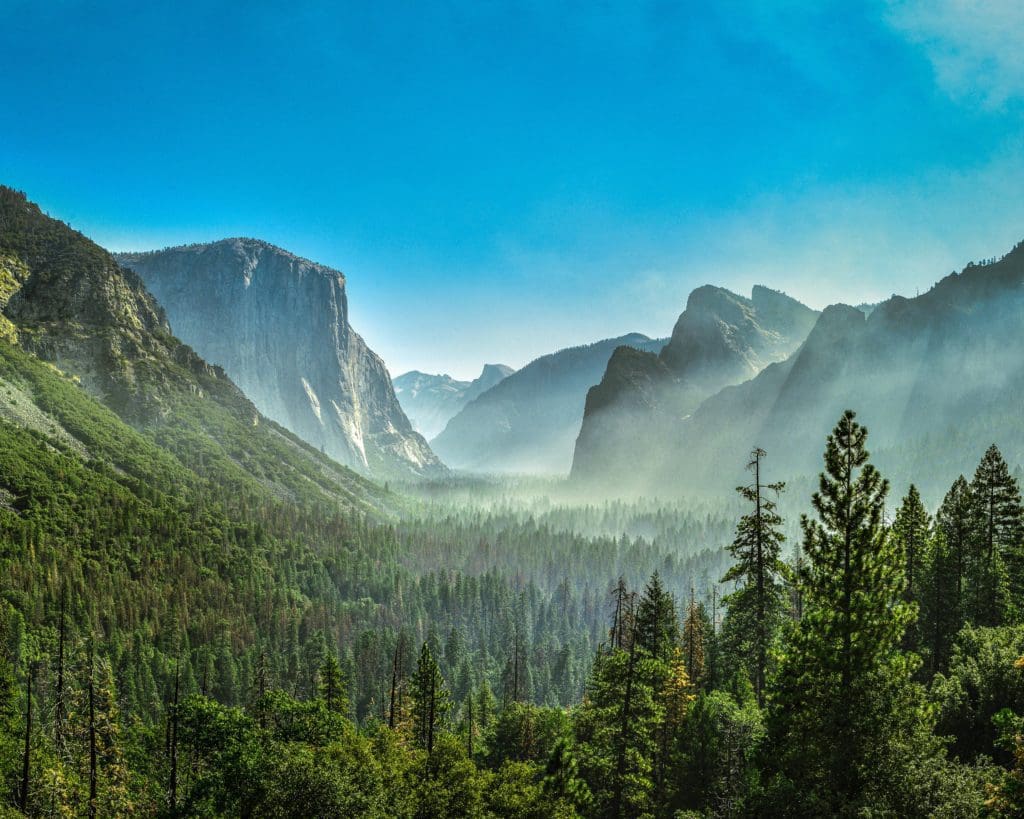
Yosemite National Park, Yosemite Valley
Table of Contents
Article Navigation: Click on any of the listed items in the table of contents below to jump to that section of the article. Similarly, clicking on any large, white section header will jump you back to the Table of Contents.
- Overview
- Humans in Yosemite
- Park Protection
- History in Stone
- Biodiversity
- Getting Around
- Places to Stay
- Must-See Attractions
- Guided Adventures
- Hiking
- Climbing
- Canyoneering
- Backpacking
- Nature Photography
- Winter In Yosemite
- Famous For A Reason
Humans in Yosemite
To simplify hugely, Yosemite’s history mirrors America’s as a whole. The land was first inhabited by natives who were swept out by European settlers. Those settlers proceeded to wreak havoc and leave no stone unturned. And eventually, the destruction was scaled back. Through this the idea that land has its own value was born, and the world was changed forever.
Native Inhabitants
The land that became Yosemite was once home to the Ahwahneechee people, one of the groups of Mono Lake People that roamed the Sierran highlands. There is evidence of them inhabiting the Yosemite Valley as old as 7,000 years. The name Yosemite is taken from the Miwok word “killer,” used to describe the Ahwahneechee, who they had skirmishes with.
But the Ahwahnechee were largely peaceful, hunting and grinding the acorns of the black oak into meal for sustenance. They practiced forest management, starting controlled burns to maintain oak tree populations by clearing away brush to provide more sun for desired trees. This practice wouldn’t be fully understood by white settlers until the 1960s, when modern forestry shifted away from dowsing wildfires wherever possible.
And so it was, until a man named James D. Savage set up a mining camp downcanyon in 1850. He was attacked by the locals, who felt his presence disrupted their lives. This raid caused a chain of events which led to the Mariposa Indian War of 1850. In short, the Ahwahnechee were displaced to reservations away from their ancestral homes, and Yosemite became the charge of European settlers.
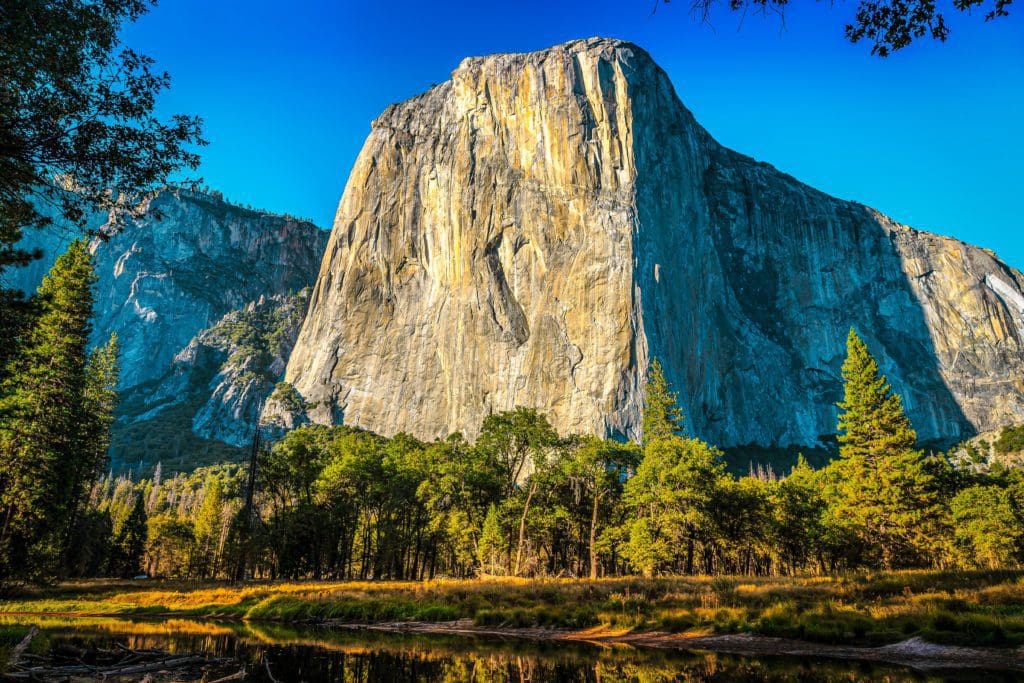
El Capitan in Yosemite National Park.
Famous Faces and Notable Names
Over the next hundred-odd years, scholars, athletes, and artists alike were inspired by Yosemite. In the mid-1800s tourists began to trickle in, and word spread quickly of the Valley’s beauty. Among these were Galen Clark, who discovered Mariposa Grove, and John Muir, one of the earliest advocates of wilderness preservation. Muir felt called to protect Yosemite from the ravages of agriculture and timber harvest. He began living in the Valley after visiting it and writing essays on the importance of nature.
His writings were impactful, gaining the attention of the government. Theodore Roosevelt later visited the park with Muir as his guide. Before they had even reached the Valley, Muir had convinced him that the land needed to be protected federally. During their trip, they camped in the backcountry and shared ideas that would shape the future of public land around the world.
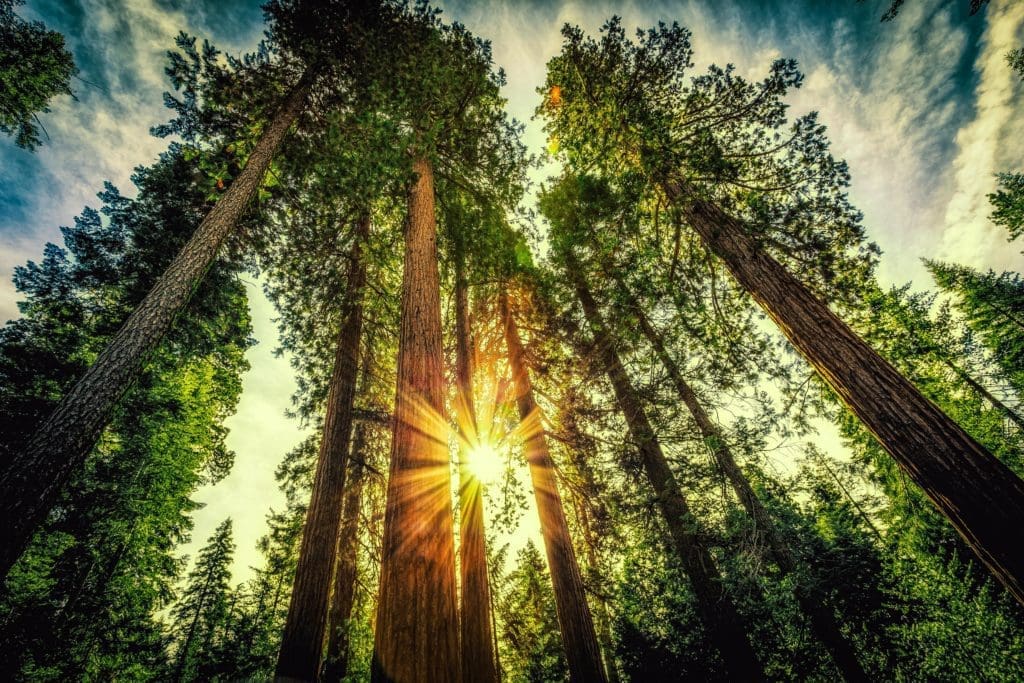
Sunrise on the Mariposa Grove of Giant Sequoias, Yosemite National Park.
Much later, young photographer Ansel Adams would find his muse in Yosemite. He joined the Sierra Club, John Muir’s brainchild, and spent six seasons in the park backcountry as a member. He helped to hang the cable along the hiking route up Half Dome and snapped enough photos for a lifetime. He then went on to become one of the most influential nature photographers of all time.
Underneath all this lofty thinking and writing, mountaineers and alpinists were quietly conquering the park’s many astounding rock faces. Originally walls were scaled by way of aid climbing, drilling holes into the rock and placing gear to ascend. This gave way to free climbing, a lower-impact method with more philosophically pure goals of climbing the rock itself, rather than just ascending by any means necessary. The accomplishments of greats like John Muir, George Anderson, John Salathé, Royal Robbins, Lynn Hill, and Jim Bridwell paved the way for achievements like those seen in Free Solo (2018) and The Dawn Wall (2017). In a very real way, the modern sport of rock climbing was born, nursed, and raised in Yosemite National Park.
Park Protection
Yosemite has given a lot to the world. Maybe its most influential contribution involved changing ideas about land use. It was one of the first places to be considered valuable just for its beauty. It didn’t need to provide gold or timber or pasture. Its splendor, the sweeping walls and wildlife, were enough.
After the displacement of the area’s native peoples, settlers began immediately grazing and harvesting whatever they could from the land. But, luckily for us, the words of a few free thinkers with big ideas caught the attention of the federal government. In 1864, President Lincoln set aside a patch of rugged California mountains under the Yosemite Grant. This made it one of the first protected areas on earth, though it wasn’t a National Park yet. This act set a precedent for Yellowstone to be named the first National Park in 1872.
The original protections given by the Yosemite Grant weren’t sufficient to preserve Yosemite. Meadows continued to be overgrazed and sequoias were cut down under the oversight of the state of California, which the Yosemite Grant had named the steward of the land. After John Muir’s trip to the Valley with Theodore Roosevelt, federal involvement in preserving the land increased quickly. In 1906, Yosemite became the country’s third National Park, quickly after Sequoia.
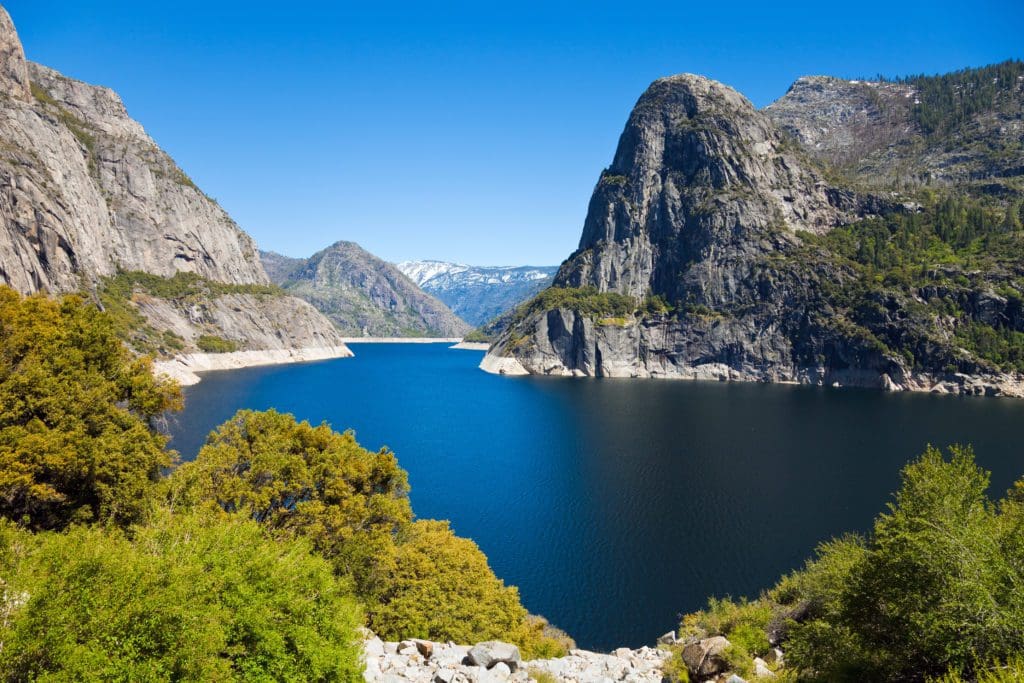
View of Hetch Hetchy Reservoir in Yosemite National Park, California.
But history doesn’t stop here. Controversies like the destruction of the Hetch Hetchy Valley, mismanagement of the park’s bears, and wildfire control have all made impacts on how land is preserved in the modern day. Ever the trendsetter, the world watches Yosemite to see how ideas about land use may change even now.
History in Stone
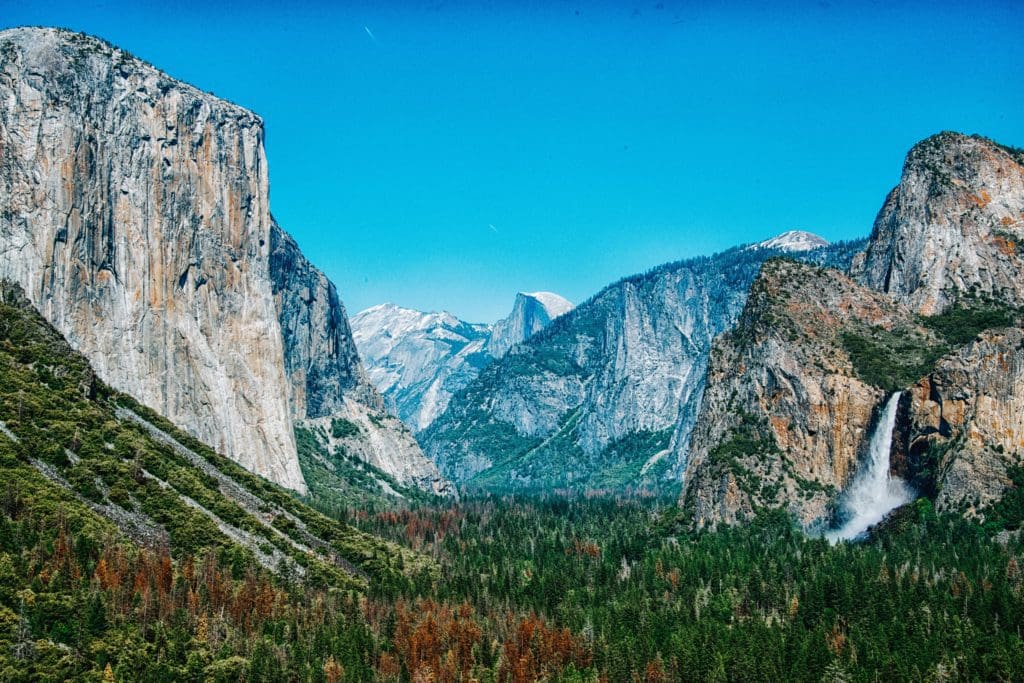
Tunnel View, Yosemite National Park
Yosemite National Park is a geologist’s playground. Every stone reveals a story thousands of millions of years old. We’re still growing to understand how the Valley came to look how it does, and in what ways it’s changing now.
The sun is settling, bringing with it curtains of fog that drift across the mountaintops. It’s the perfect time for shooting pictures with an ethereal quality.
The Power of The Sierra
One of the easiest explanations for many of the weird things we see in Yosemite is the topography of the Sierra Nevada. The range sits near the coast, providing sometimes daunting amounts of precipitation. In addition, the vertical rise of the Sierra creates a steep gradient in how that precipitation falls. The foothills, which are mostly dry, see only rain. While in the high country, whole feet of snow can fall overnight in the winter. In places throughout the Sierra, the foothills and high country may only be 15 miles apart as the crow flies. This means the erosive force of snowmelt is incredibly powerful.
The Sierras are considered a young range. The uplift that drove their formation began between five and 20 million years ago, the blink of an eye in geological time. The range popped up out of the ground after extensive subduction along the coast when the Earth’s crust beyond the western edge of the Basin and Range Province began to sink. This led to extensive volcanism and the exposure of metamorphic rock like granite, which had been developing patiently under the surface for millions of years.
Glaciation, Nature’s Chisel
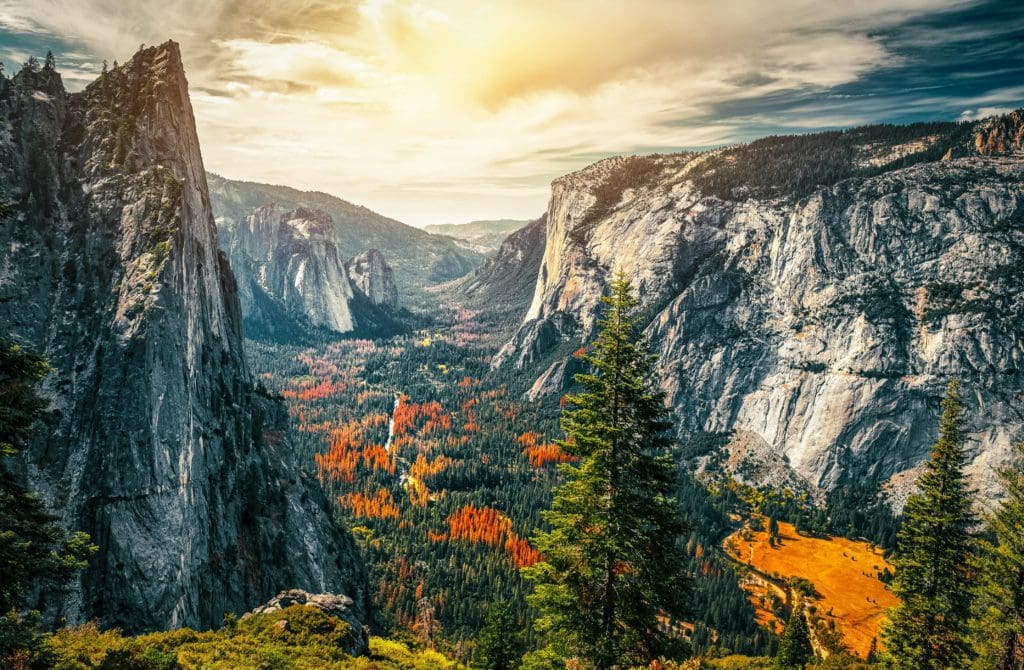
View of the Yosemite valley.
The high elevation of the peaks once allowed colossal glaciers to fill the valleys. These glaciers, which in Yosemite would have completely covered most of the valleys in the park, slid slowly forward, tearing away at the rock underneath. The process by which glaciers chip away at landscapes is time consuming, but powerful. When the glaciers receded, they left behind broad, flat-bottomed U-shaped valleys. These so-called “glacial troughs” are framed on both sides by vertical walls of pristine granite in Yosemite. This most recent development is what creates the most dramatic scenery in the park.
Floor to Ceiling Granite
Not everything about Yosemite’s geology is fully understood. We know how the park’s granite formed, and how it was exposed, but we don’t fully understand how it weathers. In many places around the park we see features called exfoliation joints. These are sheets of rock which sit on the surface of a dome, running parallel to its slope. Systems of microcracks form underneath them and cause them to slough off from time to time, causing massive rockfall. These rockfall events are sometimes huge and deadly, like the two that happened in 2017.
The processes that cause the formation and destruction of these stone sheets hasn’t been explained by geology yet, and there are many theories about how they came to be. What we do know is that these exfoliation joints give Yosemite’s rock its characteristic look. They also make much of the climbing in the park possible, creating huge splitting cracks, “chimneys”, and broad, horizontal ledges.
A Living Landscape
The hills are alive. They chirp, howl, ribbit, and titter. Yosemite National Park is teeming with living things, both plants and animals, which each have their own place in the ecosystem. They huddle through the winters and bound across flower-carpeted summer hills. They swim and flap and stot and prowl and bloom. Yosemite’s year-round residents give the landscape its vibrant color.
Climate and The Life Zones of The Sierra
What living things we see in a place is decided by the place’s climate. This is obvious in the Sierra, where ascending a thousand feet from anywhere puts you in a completely different kind of ecosystem. This is because the Sierras are a so-called Mediterranean-adjacent ecosystem. The different zones of the park may be scorchingly hot and dry, or cold and wet, at the same time.
In the Sierra Nevada Mountains, temperatures cool and precipitation increases as you climb higher. The most precipitation occurs at around 8,000 feet above sea level. Higher than this, snow becomes drier and carries less moisture. This variability in weather conditions allows plants and animals with very different strategies to make a living. In the foothills, oaks and grasses are king. Higher up, shade-tolerant trees like incense cedar and giant sequoia take over. Above this, the high-elevation experts like white fir and lodgepole pine sprawl over everything. These different niches allow different animals to specialize and thrive in one particular neighborhood.
Biodiversity
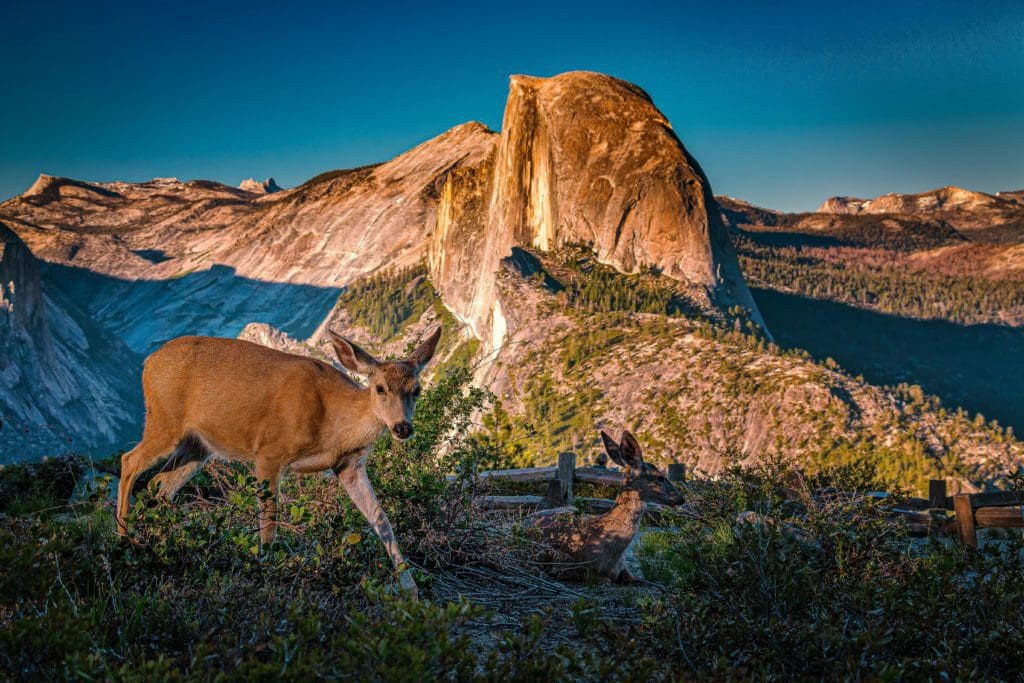
Deer near Half Dome.
Whether you’re a generalist, like the black bear, or a specialist, like the Sierra newt, Yosemite has a nook for you. The park harbors both desert species like rattlesnakes and mountain lovers like the bighorn sheep. In towering cliff bands, bats nestle into cracks as narrow as a quarter inch wide. Maybe even harder to spot are mesocarnivores like the elusive fisher and pine marten.
The forests are chock full of birds, including the secretive great gray owl, the soaring California condor, and the brilliant western tanager. A total of 262 bird species spend at least part of the year in Yosemite. You can find the park’s bird checklist here.
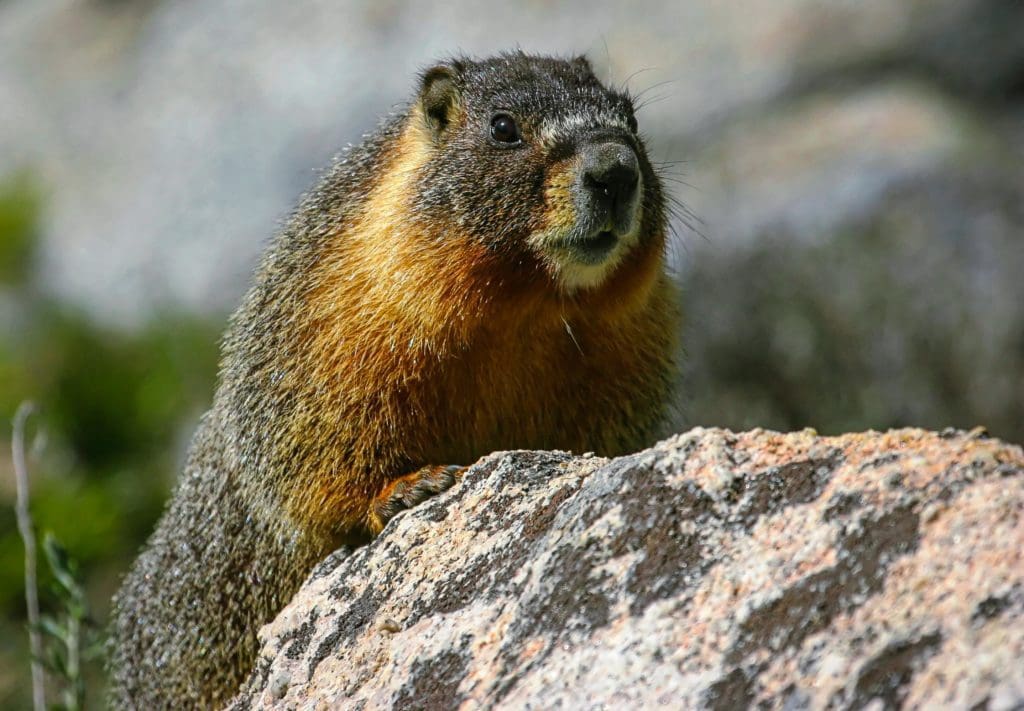
Marmot in Yosemite National Park.
If you’re taking a quick lunch between bagging peaks, you’ll probably spot marmots waddling to and fro. Pikas, undoubtedly the park’s cutest residents, are rarer. But they still dot scree slopes above tree line, gathering wildflowers to fill their winter dens with. Listen for the dead giveaway – the pika’s proud “meep” call echoes between the most exposed peaks. Be sure to bring binoculars wherever you go. There’s always something skittering through the brush in Yosemite.
Getting Around
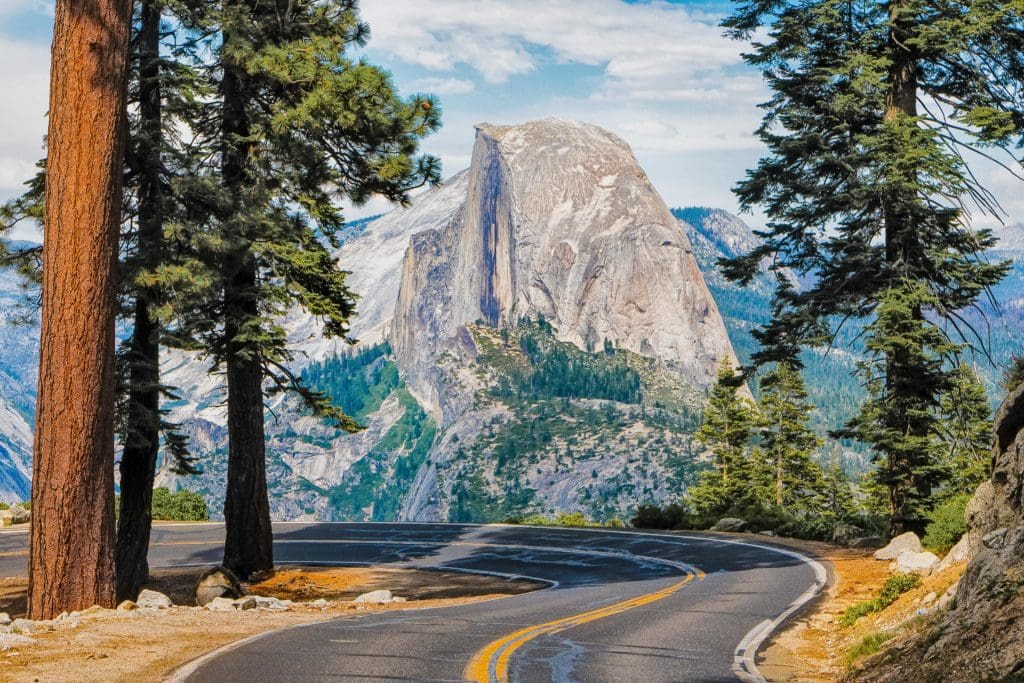
The road leading to Glacier Point in Yosemite National Park, California, USA with the Half Dome in the background.
Especially in the busy season, one of the biggest challenges to seeing Yosemite can be navigating around everyone else that wants to see Yosemite. Traffic is a big issue in the busy season in the Yosemite Valley. This is mainly because the park is a colossal area containing only three major roads; and of these, only one crosses from one park boundary to the other. So how can you plan your trip around the crowds?
Shuttle System
The park typically runs four free shuttles around different areas. The Yosemite Valley and El Cap shuttles both operate within The Valley year-round. The Mariposa Grove shuttle goes from the South Entrance to Mariposa Grove itself, usually spring to fall. In the summer, the Tuolumne Meadows shuttle services locations throughout the Meadows, including Tioga Pass and Olmstead Point.
Using park shuttles has two main benefits. First, it’s a very convenient way to make quick trips between trailheads, viewpoints, and points of interest without having to worry about parking. Second, it dramatically reduces human impact on the landscape. When possible, using shuttles helps the Park Service preserve the natural vistas we’re all clamoring to see.
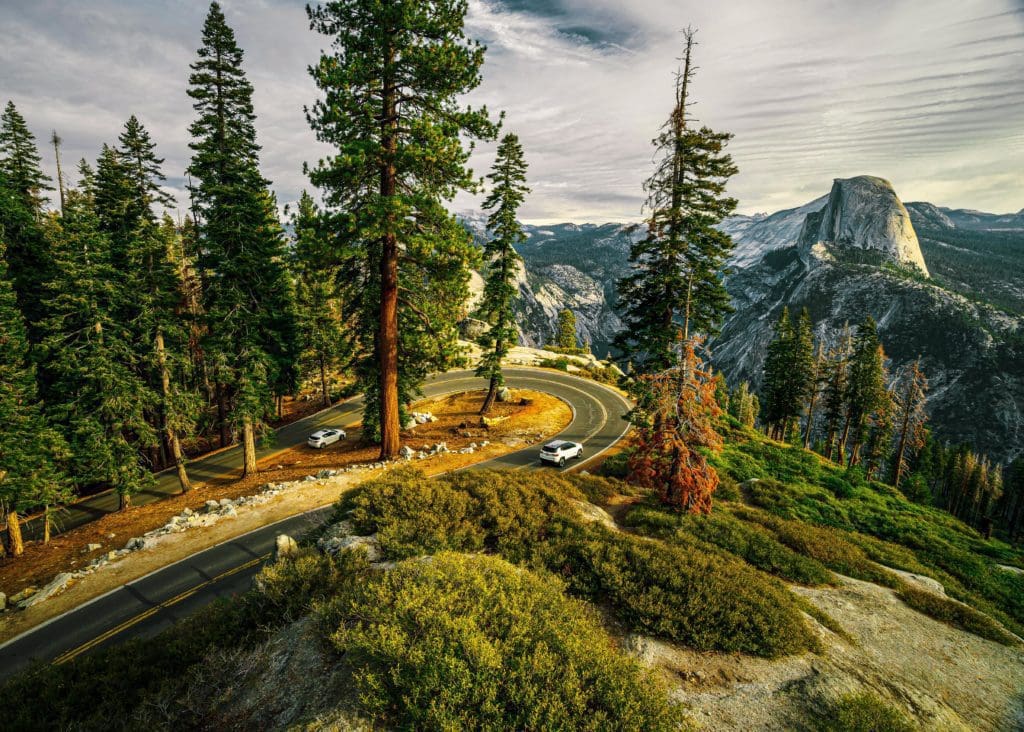
Glacier Point at Yosemite National Park.
Road Conditions and Seasons
The main deterrent to accessing Yosemite National Park is heavy snowfall. The Sierras are one of the snowiest ranges in the country. During winter in the high-elevation part of the park, especially along the Tioga Road, it will often snow whole feet in just hours.
Because of this, many of the park’s roads are closed more than half the year. The Tioga Road, Glacier Point Road, and Mariposa Grove Road all close for snow in the late fall, usually sometime in November. They remain closed until May or June depending on the snowpack. The good news is that the offseason is far slower in the typically busy parts of the park, like the Valley.
Places to Stay
Yosemite offers far more options for accommodation than the average National Park. And that’s very convenient, because it isn’t exactly close to town. Whether you’re up for roughing it or want a feather bed at the end of the day, there’s lodging to suit you inside the park.
Lodges
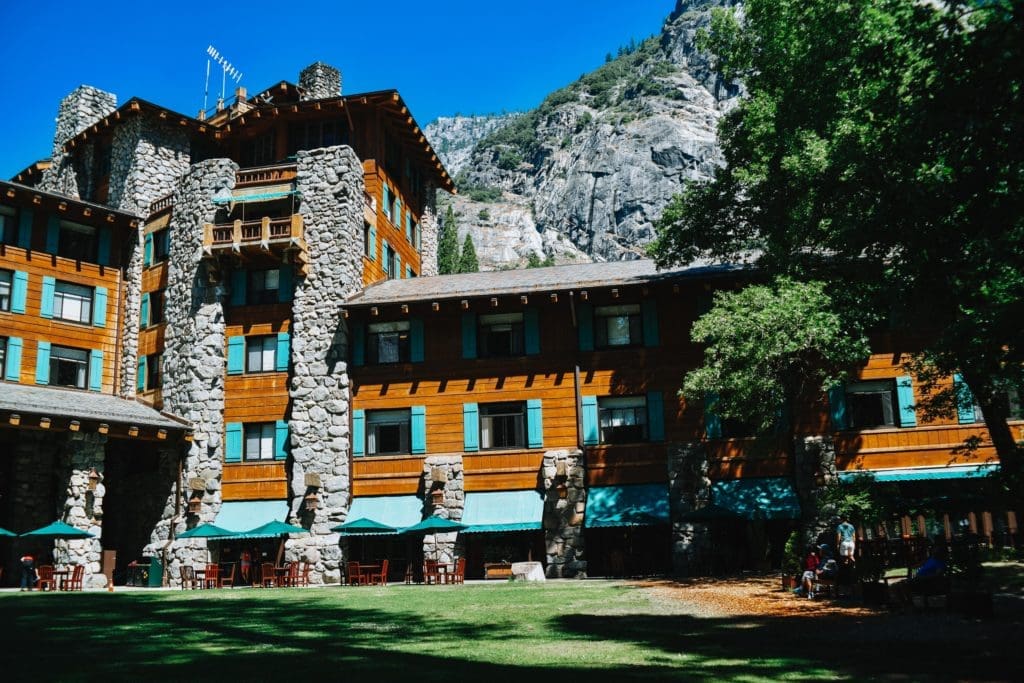
The Ahwahnee was specifically designed to highlight its natural surroundings, featuring Yosemite Falls, Half Dome and Glacier Point.
If you like to wind down from adventuring with a little civilization, Yosemite has several lodges and hotels conveniently located in the Valley. The most upscale are the Ahwanee and the Yosemite Valley Lodge. You’ll get to experience all the charms of the valley, plus a bed and a shower when you’re done sightseeing. Further south, you can also stay at the Mariposa Lodge, conveniently close to Mariposa Grove.
On the cheaper end, you can rent a cabin or tent cabin at the White Wolf Lodge or Curry Village. On the Tioga Road, there’s the Tuolumne Meadows Lodge, the highest elevation accommodation in the park. Lodging tends to fill up completely in the summer in Yosemite. So if you want to experience the park with a little luxury, be sure to make reservations far in advance.
Rent A Cabin or House with VRBO
When hotels are booked, your next best option is VRBO. If you don’t know already, VRBO is a service that lets homeowners rent out their properties for tourists to use seasonally. So, particularly if you plan on coming to Yosemite in the off-season, you can find some killer lodging just outside the valley for cheap! We dug up a few that would make for prime real estate for a backcountry ski trip or off-season climbing adventure.
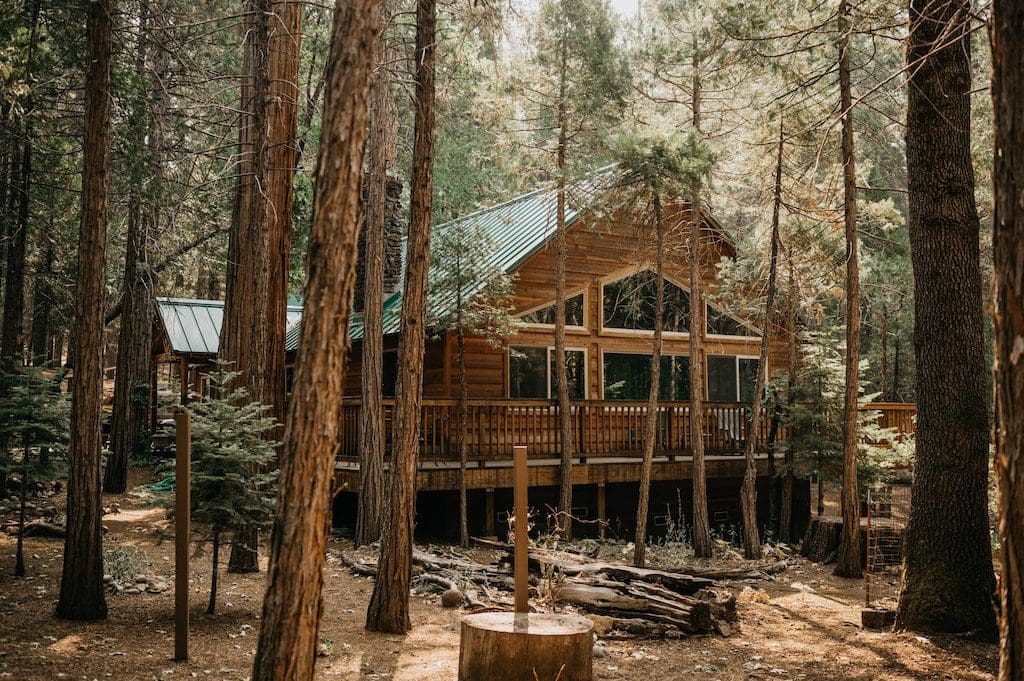
Peace of Mine is a comfortable and family friendly (pups welcome too!) cabin located inside Yosemite National Park. Photo by VRBO.
This incredible log cabin called Peace of Mine is located inside the park, is pet friendly, and houses up to seven people.
Perched on a hilltop, this cabin [ ] features a cozy living space and patio for lounging and grilling.
If you need space for more happy campers, this cabin in the Wawona area can sleep up to eight. It’s a gorgeous property with a jetted bath tub, pleasantly secluded in the woods.
Camping
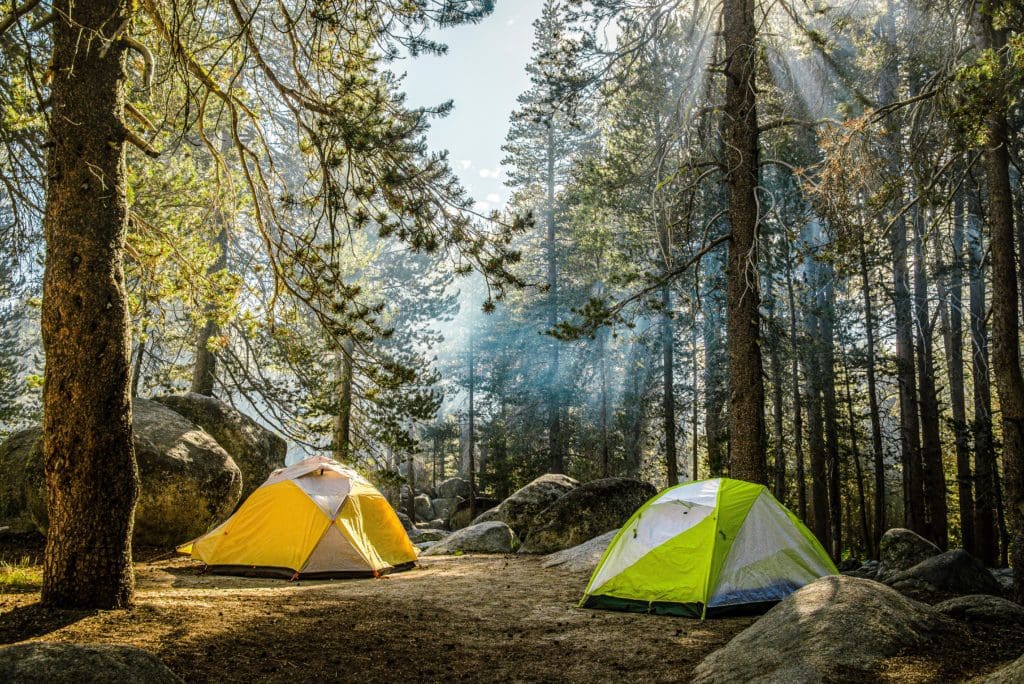
Camping in Yosemite National Park
Of course, outdoor purists will always choose sleeping out under the stars over an air conditioned hotel room. And as always, Yosemite provides. There are a total of 13 campgrounds throughout the park. Be advised that Covid has changed many campground seasons and the number of available sites. Consult with the National Park Service website for details. As always, the best plan for camping in Yosemite is to plan as far in advance as possible.
In the Yosemite Valley, Upper Pines is the main year-round, high-capacity campground with 238 total sites. Lower Pines and North Pines (open during the busy season) are situated adjacent, with 60 and 81 sites each. All have good access to the river, lovely shade trees, and fantastic views of the overhanging domes. The other option in the Valley is Camp 4, a hike-in camp typically used by climbers who want to get a little further off the grid while camping in the park.
South of the Valley, you’ll find Wawona and Bridalveil Creek Campgrounds. Wawona is a solid access point for Mariposa grove, with 93 sites. Bridalveil Creek is located much higher up in the mountains, at around 7200 feet elevation. It has 110 sites, and is less often visited by campers. Either of these options are perfect if you want to see a different part of the park from most people.
Along the Tioga Road, there are seven additional campgrounds. They proceed up in elevation as you go along, topping out at Tuolumne Meadows campground. This might be the most panoramic campground in the park, sitting at 8600 feet. You’ll be dead center in the park’s high country, surrounded by rocky peaks and alpine meadows crisscrossed with babbling creeks.
Along the Tioga Road, campground sizes vary a lot. On the low end, Porcupine Flat has just 52 sites, whereas Tuolumne Meadows has 304 in total. Being on top of the Valley gives you lots of different options for activities, hikes, and sights. If you camp along the Tioga Road, take in the unique scenery of the high country and enjoy the lack of crowds found in the Valley proper.
Must-See Attractions
If this is your first trip to Yosemite, there are a few things you can’t miss. And if you’re returning, you’ll probably want to see these things again! Yosemite is home to some of the most fantastic natural sights in the United States, if not the world. And astonishingly, most of them are packed tightly together. Almost all of the park’s “postcard picture” views are located in the Yosemite Valley, the main drag of the park. These photo-ops are worth battling the crowds.
But outside the Valley, there are still plenty of things to see worth your time. In fact, if you have the time, we encourage you to strike out away from the crowded areas and find some of Yosemite’s hidden gems. If you have a long weekend in the park, these are the things you shouldn’t miss.
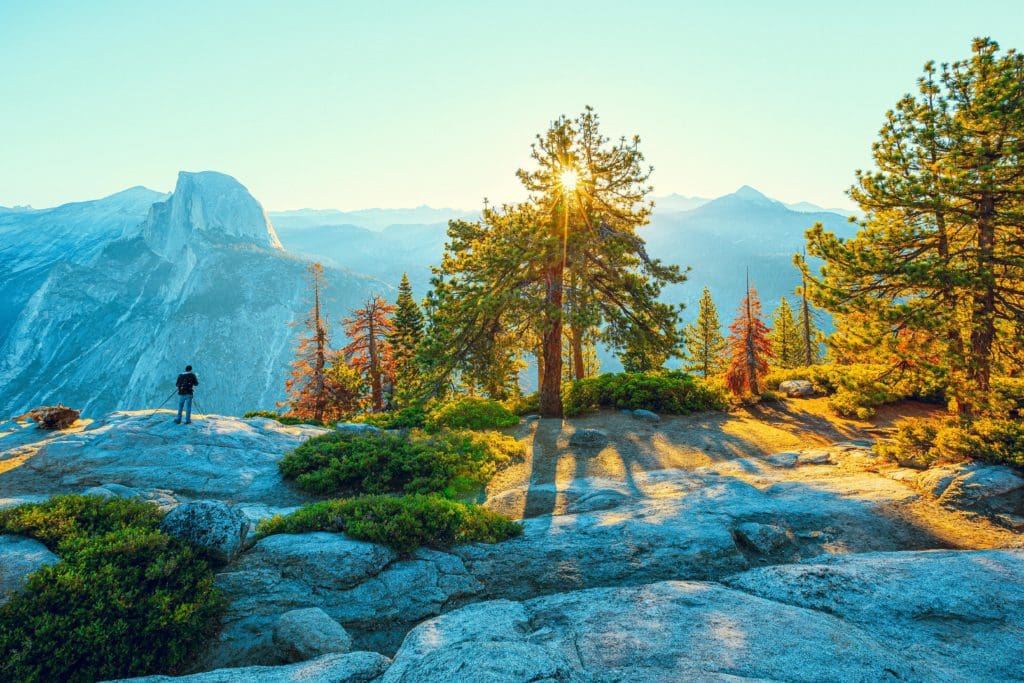
Fantastic overlook at Glacier Point in Yosemite national park
Granite Domes
Aside from being astoundingly grand in general, Yosemite is probably most well-known for its towering granite domes. These faces of rock are among the tallest on the continent, made up of perfectly polished white-gray granite. The most notable are Half Dome and El Capitan, made famous of late by films like The Dawn Wall and Free Solo.
Yosemite’s granite domes are more than just cliffs. They’re vertical oceans of stone that have to be seen to be believed. They top out thousands of feet above the valley floor, as sheer as ten skyscrapers stacked on ten skyscrapers. Even less recognizable domes like Sentinel Dome, North Dome and Quarter Dome defy description. If you don’t take at least an hour to just stand beneath them and feel incredibly small, you will be missing out.
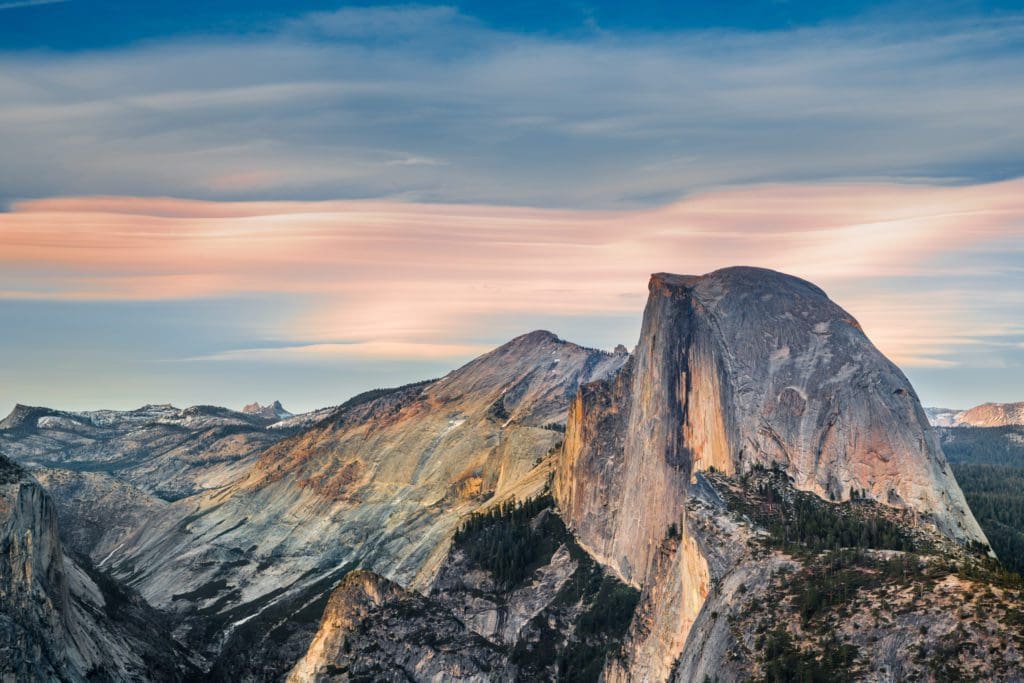
Half Dome at Sunset, Glasier Point.
Waterfalls
If Yosemite Valley were a painting, and the granite domes were the main subject, they would be framed by thousand-foot-high waterfalls. The park has exactly four waterfalls taller than a thousand feet, in fact. Chiefest among these is Yosemite Falls, a staggering 2,425 feet tall. It’s one of the tallest of earth, charging forth from a cleft in the rock and spraying into a thick mist over the valley floor. It’s so powerful that in the winter it covers the entire surrounding wall in a thick coat of ice.
But biggest doesn’t necessarily mean best. Sentinel Falls (2,000 feet tall) splashes and rolls over shelves of rock as it descends into the Valley, while Ribbon Fall (1,612 feet tall) drops in a single, breathtaking straight shot. One of the most famous anomalies in the park is Horsetail Fall, only a “measly” thousand feet tall, which glows brilliantly red in the February sunset. Everywhere you turn in Yosemite National Park you’ll spot waterfalls hundreds of feet tall, each spectacular in its own way.
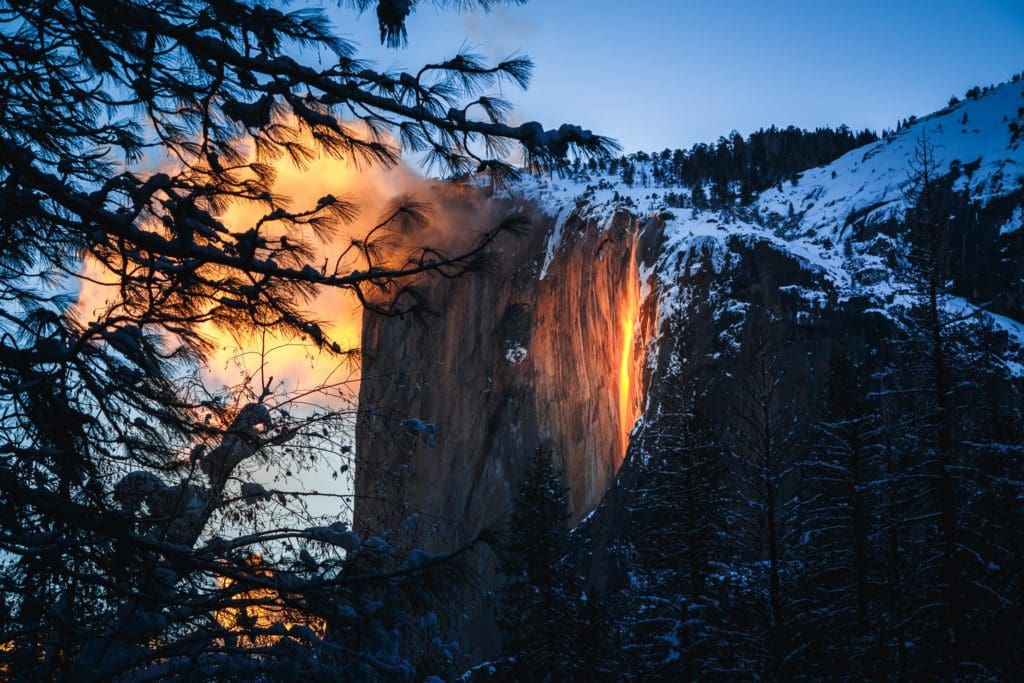
Horsetail Fall flows over the eastern edge of El Capitan in Yosemite Valley. This small waterfall usually flows only during winter and is easy to miss. On rare occasions during mid- to late February, it can glow orange when it’s backlit by sunset.
Sequoia Groves
Even if you’ve already been to Sequoia National Park, the sight of a 200-foot-tall tree will probably still knock your socks off. Yosemite has sequoia groves of its own, though not on the scale of Sequoia and Kings Canyon to the south.
But that doesn’t make the trees any less gigantic or wonderful to behold. The largest in Mariposa Grove, just inside the south entrance of the park, is the Grizzly Giant. It’s a behemoth by any measure, standing 209 feet tall with a trunk 25 and a half feet in diameter! Hiking around Mariposa Grove and shrinking before these goliath sequoias is a must for anyone who has never seen them before.
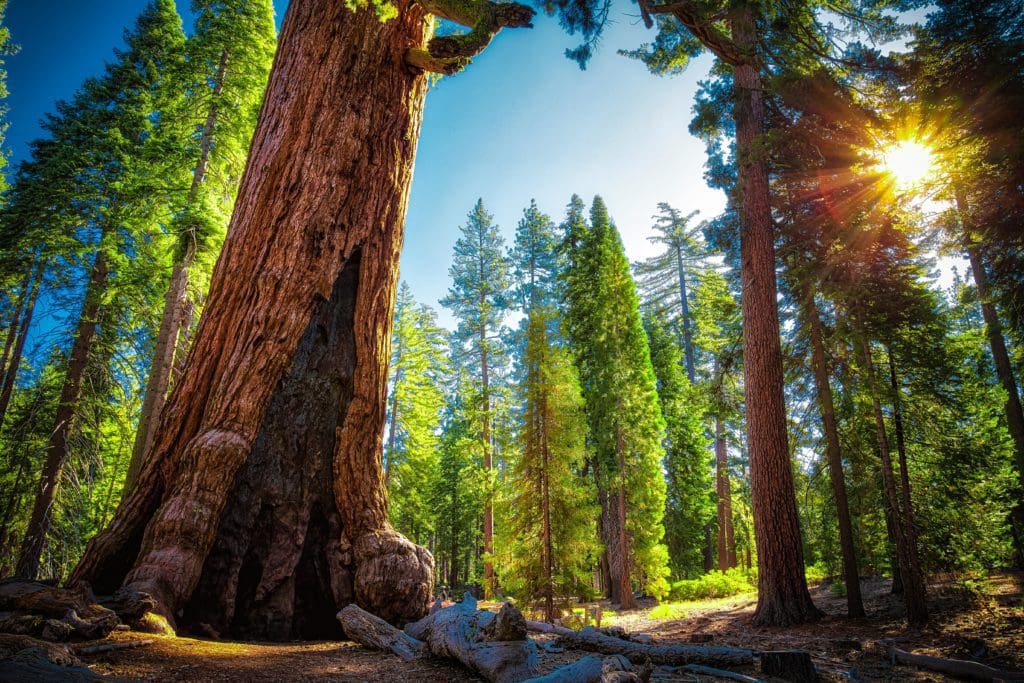
Grizzly Giant at Mariposa Grove of Giant Sequoias, Yosemite National Park California
Alpine Wilderness
Part of the majesty of the Sierras is the changing scenery as you ascend from foothills to alpine grasslands. You’ll pass through many distinct ecosystems and watch the trees change until you arrive in the high country. Near Tuolumne Meadows, trees become sparse again. In their place you’ll find idyllic grassy meadows speckled with a rainbow of wildflowers, crystal clear water, and landscapes of stone polished smooth by glaciers.
While up in the clouds, you’ll see far-off summits like Cathedral Peak glinting in the sun, and maybe even some high mountain wildlife. There are few places in the Sierra where you can drive into the alpine. It’s a privilege few have enjoyed to access something guarded by rocky peaks so easily. Definitely take the time to see it.
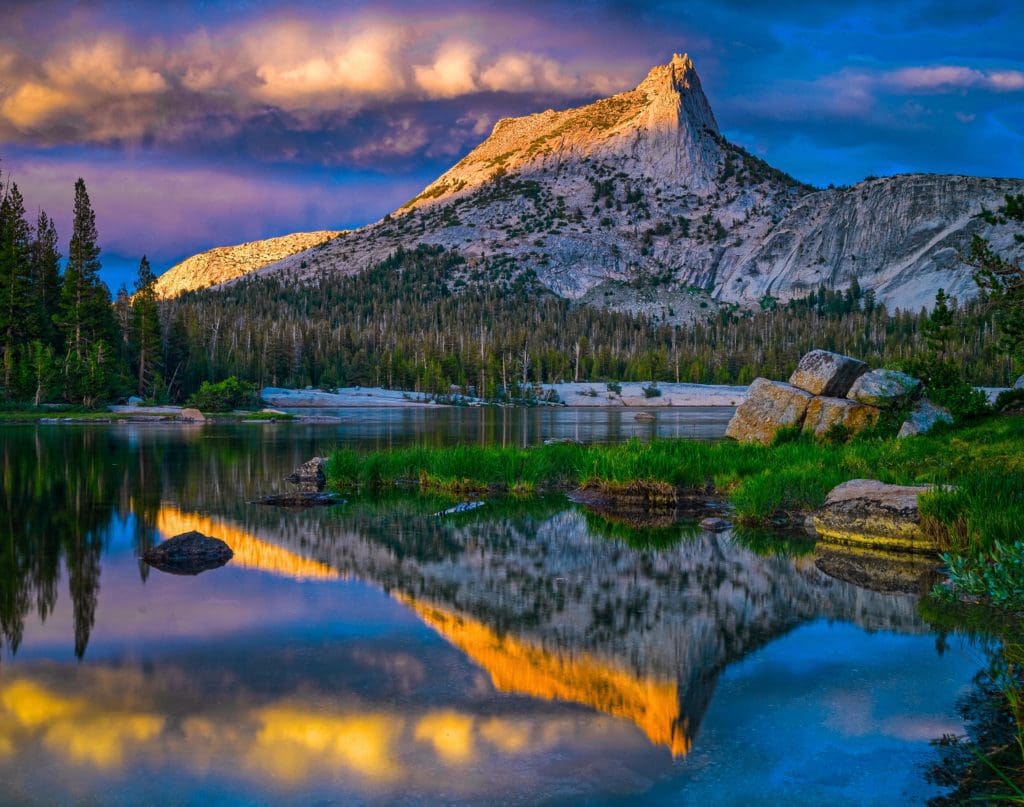
Cathedral Peak is a popular peak in the Toulumne meadows area in Yosemite National Park.
Guided Adventures
Taking on huge outdoor adventures by yourself isn’t for everybody. But if you’re new to adventure sports or the outdoors in general, that doesn’t mean you have to sit on the sidelines. There are plenty of guiding services in Yosemite National Park that help empower newcomers to explore the backcountry. Here are our top picks for hiking, backpacking, and climbing in Yosemite.
REI Adventures
REI are long-time experts in all things outdoors. When suiting up for an adventure, your local gear co-op will never let you down. But they also host guided adventures all over the country, including in Yosemite. There are 14 in total, including winter hiking trips, backpacking the high country, and lodge-based hiking trips that add a little more comfort to the experience.
57 Hours
57Hours is a growing service which connects certified guides to people looking to make the most of their free time. They offer three backpacking trips within Yosemite around different areas of the park, each totaling five days in the backcountry. Distances range from 26 miles, a leisurely pace, to 42 miles, much more difficult.
Routes include the High Sierra Loop, Grand Canyon of the Tuolumne, and the “Hidden Yosemite” trip. The latter focuses on getting you into some of the park’s spacious, quiet backcountry, where the best-kept secrets are.
Yosemite Mountaineering School and Guide Service
There’s no one better equipped to show you the ropes (pun intended) at outdoor rock climbing than the Yosemite Mountaineering School. Yosemite is a goldmine of outstanding big wall routes, including El Capitan, often called the greatest wall on Earth. And with a guide, you could even take on The Captain. The trip totals six days on the wall, sleeping on a port-a-ledge, and costs $7000.
If that’s a little rich for your blood, don’t worry. Full days on the wall go for $230-425, depending on your group size. This is an ideal way to level up your climbing ability from “competent” to “yeah, no big deal, I climb big walls in The Valley.” Guides will help you push your limits and increase your understanding of gear and technique, giving you room to grow.
Hiking
Yosemite has over 800 miles of hiking trails winding over, around, and through its peaks and valleys. It’s hard to know where to even start with numbers like that. We took on the burden of research and created a list to get you there a little easier. Here are some trails listed by their difficulty, each with a serene objective.
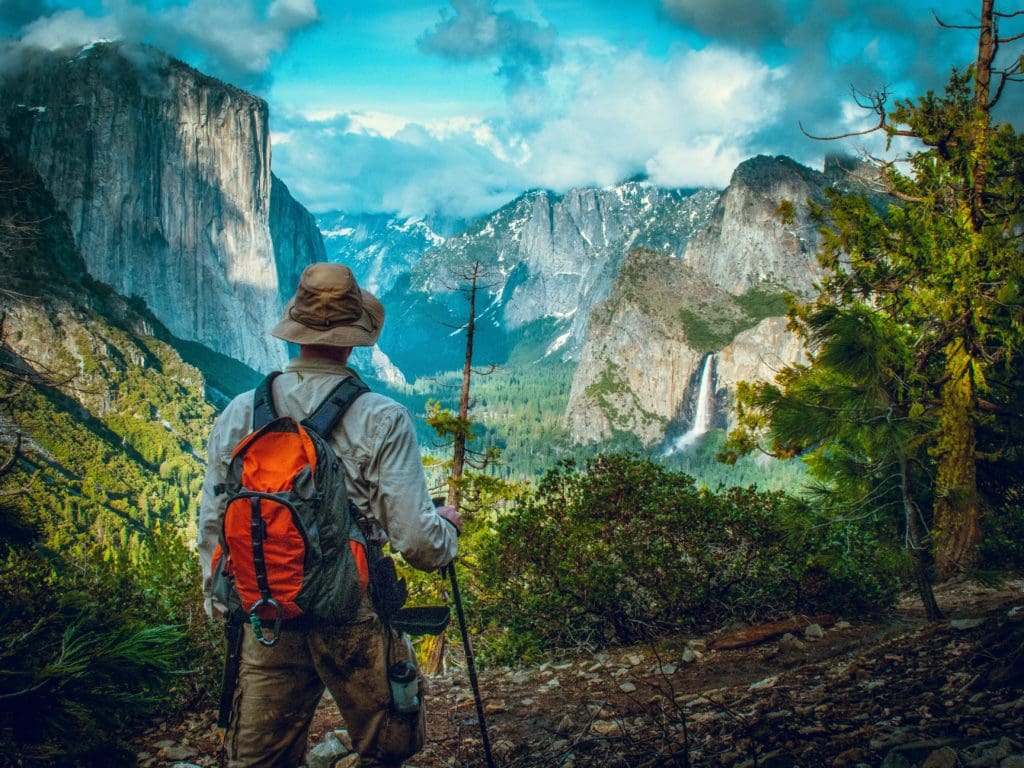
Hiker Pauses to Enjoy a View of Bridalviel Fall
Easy Trails:
Lower Yosemite Falls Trail
This trail is a must for any first-timers to the park. If you’re doing a quick drive around the valley and want to get out of the car and see something without committing much time, well, here you go. It’s a 1.2 mile loop that gains almost no elevation and includes a view of the Lower Yosemite Fall. The trailhead is right next to the Yosemite Lodge in case you need to pick up snacks. It’s a perfect way to kill an hour.
Glacier Point Trail
At the end of the Glacier Point Road, you can hop out of the car, hike an extra half mile or so, and get one of the best views in the park. It’s an iconic vista of Half Dome, North Dome, and Clouds Rest beyond. Another quick and easy walk with a huge payoff.
Sentinel Dome Trail
With just a little more effort than the Glacier Point Trail, you can top out Sentinel Dome and get an even wider view of the Yosemite Valley. This out and back trail measures 2.1 miles total and gains 450 feet to the summit of Sentinel Dome. From there you’ll be able to see not only Half Dome but also El Capitan, Eagle Peak, and hundreds of other high points rolling off past the horizon.
Tuolumne Grove Trail
Tuolumne Meadows is a major hub for hiking trailheads. On the low-commitment end, the Tuolumne Grove Trail offers great payoffs for nature watching. Over a total of 2.8 miles you’ll venture into a sequoia grove and probably spot some wildlife along the way. It gains 650-ish feet along the way, putting it on the high end of “leisurely”.
Moderate Trails:
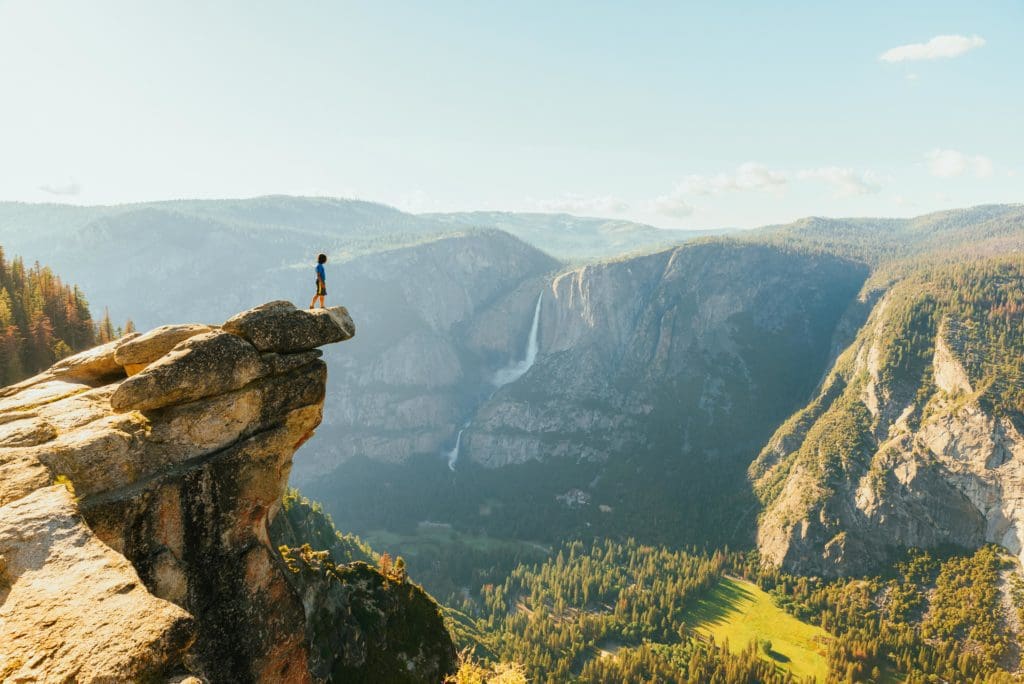
Hiker at the Glacier Point with View to Yosemite Falls and Valley in the Yosemite National Park, California, USA
Sentinel Dome and Taft Point Loop
This trail adds a bit of distance and elevation onto the Sentinel Dome Trail. It gives wider views of Yosemite, traversing across the precipice above the Valley to Taft Point. At 5.1 miles and 1,100 feet of elevation in total, it’s a longer endeavor, but a worthwhile effort.
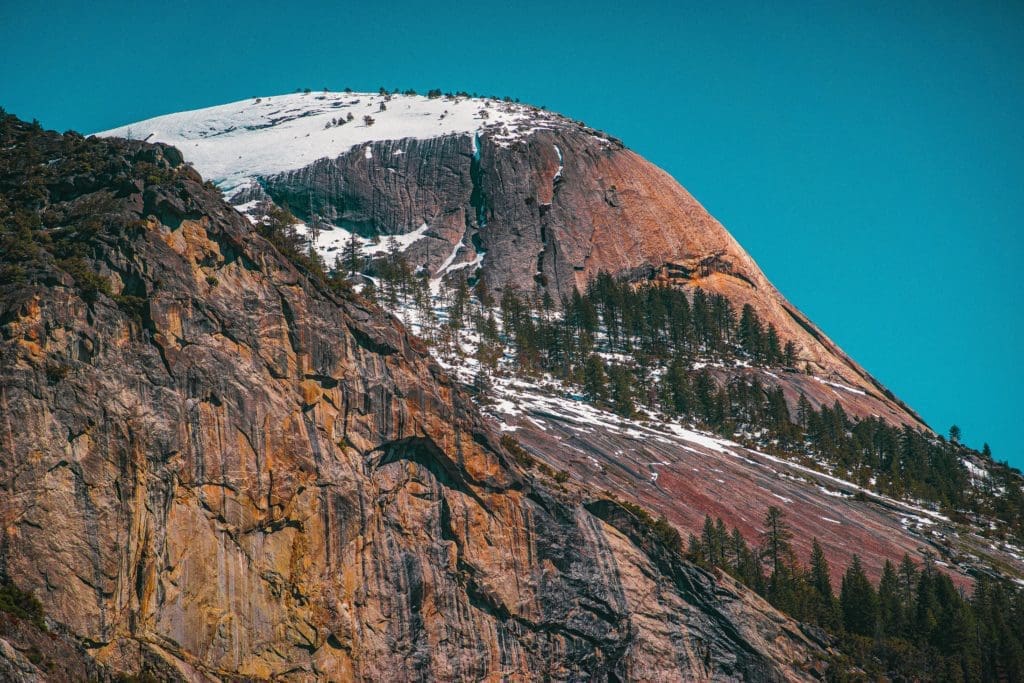
Sentinel Dome
Mirror Lake Via Valley Loop Trail
Beginning just beyond the end of the road at Upper Pines Campground, this trail takes you further upcanyon along Tenaya Creek. You’ll pass under Half Dome, Basket Dome, and North Dome, circling Mirror Lake in the process. It’s a peaceful, flat stretch of river that seems to urge you to slow down and take it all in.
Mariposa Grove of Giant Sequoias Trail
The Mariposa Grove Trail is imperative if you’ve never seen giant sequoias. These gigantic trees are staggering to even look at. Wandering through them at a slow, steady pace feels like being transported to another planet. The loop covers 6.2 miles and 1,200 feet of gain.
Difficult Trails:
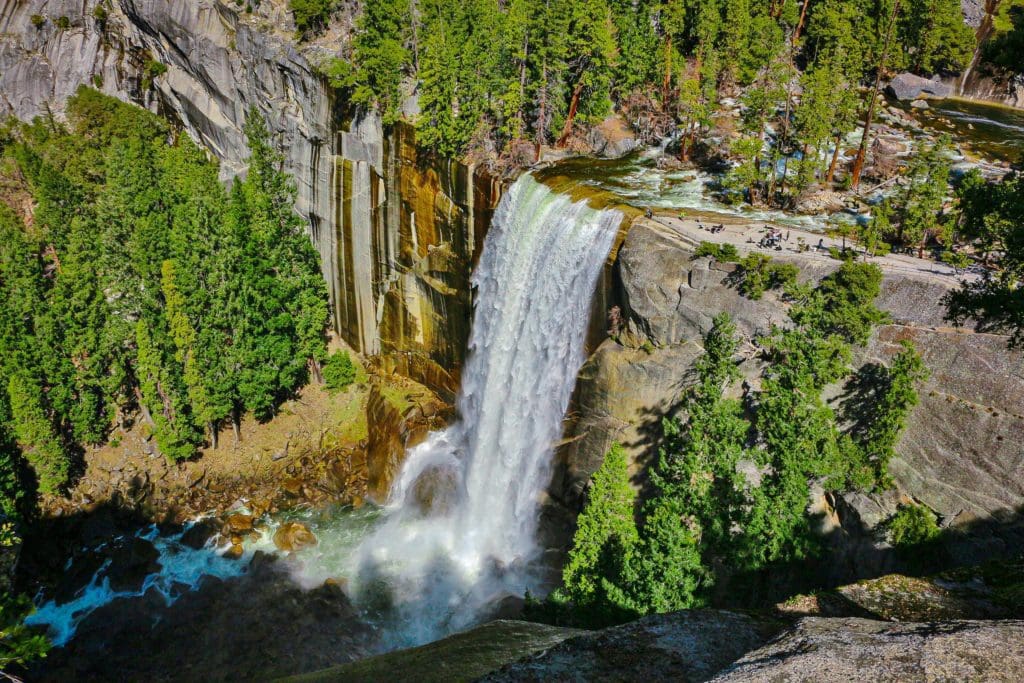
Stunning Vernal Fall at Yosemite National Park with viewing platform.
Nevada and Vernal Falls via Mist Trail
Getting to Nevada and Vernal Falls doesn’t take more distance than some of the moderate trails on this list, but the path is considerably steeper. What you get for your extra sweat is up close views of two charging waterfalls, passing within arm’s reach of Liberty Cap. It’s an intimate trek into the more rugged parts of the Yosemite frontcountry, capped off with some outstanding sights. Be sure to bring a rain jacket, the trail goes into the splash zone beneath each waterfall.
If you don’t have quite enough time for the whole thing, you could instead go as far as Vernal Falls and turn back. The distance is much milder, a total of 4 miles, with only 1,279 feet of gain.
Upper Yosemite Falls Trail
A tough ascent to the upper portion of Yosemite Falls. It’s a 7.6 mile out and back that gains 3,200 feet before losing it all again. Be prepared for lots of switchbacks on the way up, and breathtaking views as Yosemite Creek plunges all that distance straight back down to the rocky floor of the Valley.
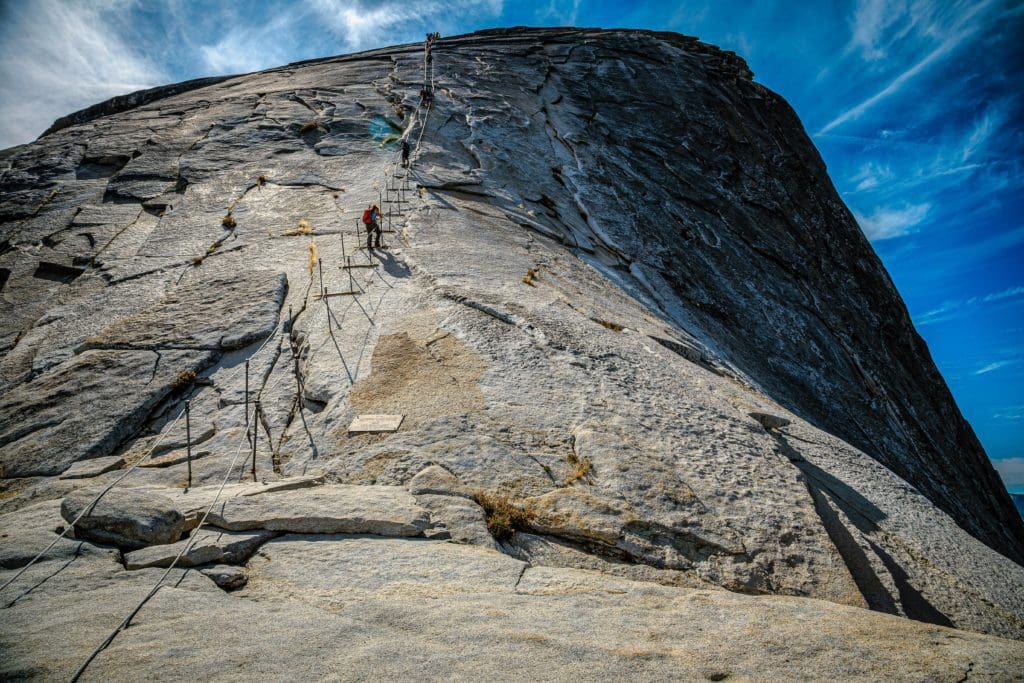
Climbing the Half Dome Cables in Yosemite National Park.
Half Dome via the John Muir Trail
Walk where John Muir once walked, see what he once saw. And realize quickly that John Muir was no slouch at hiking. You’ll ascend almost 5,200 feet and cover 15 total miles, summiting Half Dome in the process. While you climb the slabby white granite, you’ll hang on to a metal cable that Ansel Adams once put up and took down himself. This is a journey back in time that brings us closer to some of Yosemite’s biggest fanatics.
Climbing
Where to even begin? Yosemite is Mecca for climbers. It features some of the most jaw-dropping big walls in the world. Just so we don’t all get overwhelmed, we’ll separate some of the must-sees by difficulty.
Be prepared, most climbing in Yosemite is done on trad gear, although there are some boulders and sport routes here and there. Furthermore, know before you go that the standard for “easy” here is a couple notches harder than most places. Yosemite is pretty sandbagged in general, especially when taking into account the extra trouble involved in taking on a multi-pitch route.
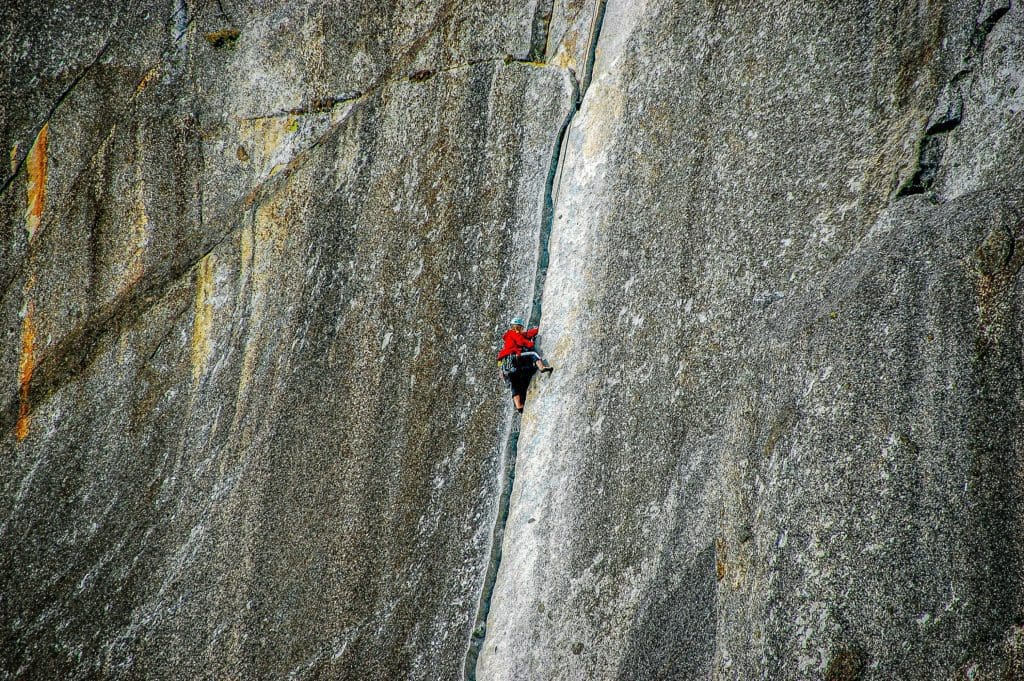
Solo Rock Climber in Yosemite National Park.
Easy Climbs
Mockery (5.8 Sport, 1P)
If you’re looking for an easy sport climb to warm up on, Mockery is a fine place to start. It’s on the Five and Dime Cliff, surrounded on both sides by other fairly easy sport climbs. This will give you a taste of what you’re in for in Yosemite – that is, sharp granite, little holds, and big walls.
Nutcracker (5.8 Trad, 5P)
If you’re ready for a true Yosemite Valley classic, Nutcracker should be on your list. It’s a popular route, so better if you’re in Yosemite in the off-season. It’s a long, steady ascent of the luxuriously-named Manure Pile Buttress.
Central Pillar of Frenzy (5.9 Trad, 5P)
The Central Pillar of Frenzy is a picturesque line up the most noticeable pillar on the left side of the Middle Cathedral. First ascended by Yosemite legend Jim Bridwell, its popularity is earned. Get your hands taped up and ready for some crack moves.
Intermediate Climbs
Sons of Yesterday (5.10- Trad, 6P)
Going steadily up the difficulty ladder, Sons of Yesterday is called one of the best 5.10s in the Valley. It’s actually the continuation of Serenity, the first three pitches up from the ground. Neverending crack, good protection, and an ocean of rock to spread out on. How could you not love it?
Reed’s Pinnacle Direct (5.10a Trad, 3P)
In the same ballpark difficulty-wise, though shorter, Reed’s Pinnacle is a superb wall covered in great hand cracks. The third pitch involves a long chimney to top out. It’s exposed, it’s scary, it’s invigorating.
Royal Arches (5.10- Trad, 15P)
The Royal Arches are even more spectacular than what you might picture. These sloping, overhanging roofs soar over hundreds of feet of rock and the distant valley floor. It can be climbed via aid at 5.7 or free at 5.10-. It was an early first ascent, in 1936, and groundbreaking at the time. Another piece of history in the sport of climbing.
Expert Climbs
The Nose (5.9 Trad, 31P)
It may not be the highest grade, but if you’re climbing 31 continuous pitches of Yosemite granite, then congratulations, you’re an expert. The Nose is one of the most famous routes in Yosemite, first ascended free by Lynn Hill in ’93. Most parties will have to bivvy on the wall. Most parties will cry when they come to the Great Roof. But anyone would be psyched just to climb El Capitan, much less in such style.
Salathé Wall (5.9 C2 Aid, 5.13b Trad, 35P)
More bang for your buck. Wider cracks, more pitches, lots of ledges to sleep on. It’s possibly the longest route on The Captain, totaling 3,500 gorgeous vertical feet of white granite. If you’ve got the gear and the guts, prepare for some monstrous off-width and earn yourself the glory.
The North Face of The Rostrum (5.11c Trad, 8P)
The Rostrum is another unbelievable wall shooting up out of the Yosemite Valley. Locals will tell you that if you were to cut this climb up and put each pitch on one wall, they would all be classics. It’s a sustained joyride all the way through that will test your technical prowess. Laybacking, chimneys, hand and foot jams, it’s got it all.
Canyoneering
People in the Valley might look at you sideways for breaking out a skinny rope to rappel on, but there’s some pretty solid canyoneering in Yosemite. The bonus is you won’t battle crowds like you will climbing big walls or hiking. It’s a nice option for getting away from crowds and having some space to think. But be aware: most of the canyons in Yosemite require big ropes, and can be extremely dangerous when the water is high. Before you go, be diligent to keep an eye on flow, and make sure you’ve got the right gear (and the skills to use it). Here are some of the gems found around the park.
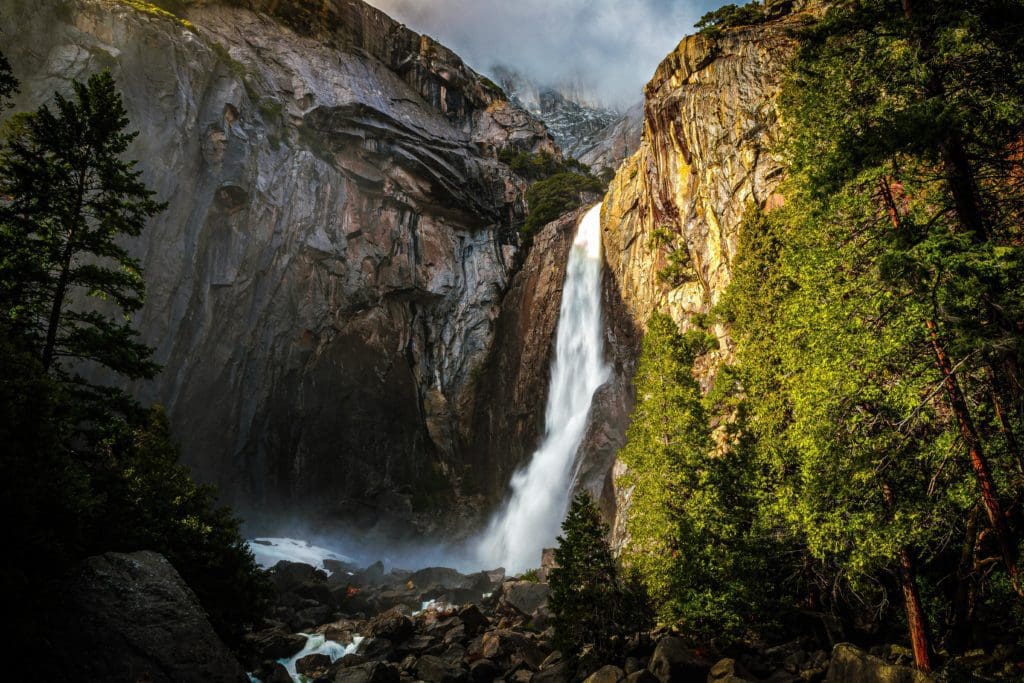
Yosemite Falls
Middle Earth (4C III R)
Middle Earth, also known as the Inner Gorge, is the crown jewel of canyoneering in Yosemite. It spans from the bottom of Upper Yosemite Falls to the top of Lower Yosemite Falls. Though it’s rated R, danger can be mitigated by going at low flow and familiarizing yourself with multipitch rappelling techniques. There are two approaches, one which involves a standard hike and another that begins with a technical rock climb. If you like multi-sport adventures and fun ropework, that’s about as good as it gets! To spice this route up, you can tack on Upper Yosemite Falls, totalling 1,500 feet of rappelling.
Tenaya Canyon (3B IV)
Tenaya Canyon is neither a highly technical descent, nor a walk in the park. If you’re a fan of sporty canyoneering with easy rappels and even a few dives (who isn’t, really?), this route was made with you in mind. None of the raps are scary big, the largest being 70 feet. The biggest jump is around 30 feet. It’s mostly just a pleasant trip through the “backcountry” of the frontcountry.
Snow Creek (3C III)
Snow Creek is probably the least crowded route on this list. It’s tucked at such an angle that there aren’t really good views of the canyon without getting right into it. It involves 11 rappels total, many of which use natural anchors, at a max of 220 feet tall. You can swim if you like, or avoid it if you don’t. It’s one of the only routes in Yosemite where you could get away with not wearing a wetsuit. Keep an eye on flow as always.
Backpacking
As Yosemite holds some of the wildest country in California, it’s not hard to imagine just walking up into the hills and going for days on end. There are tons of destinations and ways to get to them throughout the backcountry. It’s only a little more complex now than it was in John Muir’s day. Consult with the park about your route, practice Leave No Trace, and respect wildlife while in the backcountry, and the world is your oyster. Here are some ideas to get you started daydreaming.
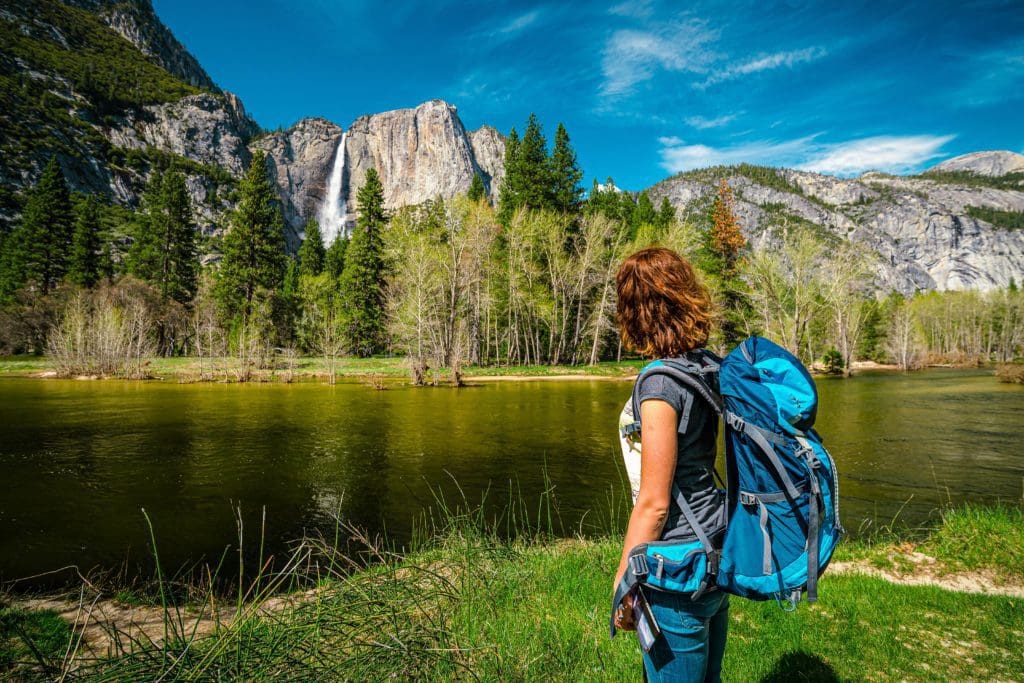
Backpacker admiring Yosemite falls near Merced river in Yosemite valley.
Young Lakes (13.6 mi round trip, +/-1,389 ft)
If you don’t have a ton of time to commit and want to get away from crowds, Young Lakes is perfect. The route heads north from Tuolumne Meadows, ascending the total elevation gain in a straight shot. You’ll find yourself surrounded by alpine lakes and pristine peaks. Looking back as you climb, you’ll get views of Tuolumne Meadows. Permits are easier to get than other routes nearby, meaning less headache with paperwork and more privacy.
Benson Lake (50 mi loop, +/- 10,000 ft)
Some of us are never satisfied with one to two night outings. It’s “epic adventure for the ages” or nothing. The Benson Lake Loop definitely fits this description. Commonly done in five-ish days, the trail traverses 50 miles of remote country in the northeast corner of the park. It gains about ten grand in elevation over that distance, enough to climb to some of the places you’ll be from the ocean. The route crosses through stupendous alpine wilderness; lakes fed by glaciers, picturesque granite peaks, and untamed woods are all on the docket. If you’re the all-or-nothing sort, this one’s for you.
Yosemite Highlights Loop – Tuolumne Meadows to The Valley (40 mi loop, +/- 9,000 ft)
The Yosemite Highlights Loop is probably the best way to see all the major sights in the park. You’ll see the valley from above, amble through Tuolumne Meadows, and get more intimate with the park’s side canyons. Even better, you’ll do it without battling traffic the whole time. It’s a hearty trip, with large distances and strenuous climbs. But if you didn’t have to struggle for it, it would probably be a paved road.
Nature Photography
One of the most satisfying ways to pass the time in Yosemite is looking for great photo-ops. There are always interesting angles and moments happening here, like the first glimmer of light striking the Dawn Wall, or the “lava fall” effect that happens to Horsetail Falls in February. The key is to position yourself patiently, bring your zoom lens, and stay observant.
People are constantly finding new phenomena that haven’t been photographed yet in Yosemite. There’s also a lot of opportunity for wildlife photography, between the park’s bumbling bears, the hundreds of bird species, and more elusive characters like bighorn sheep. Suffice it to say that Ansel Adams’ long tenure as a Yosemite photographer barely made a dent in all the photo-ops the park has to offer.
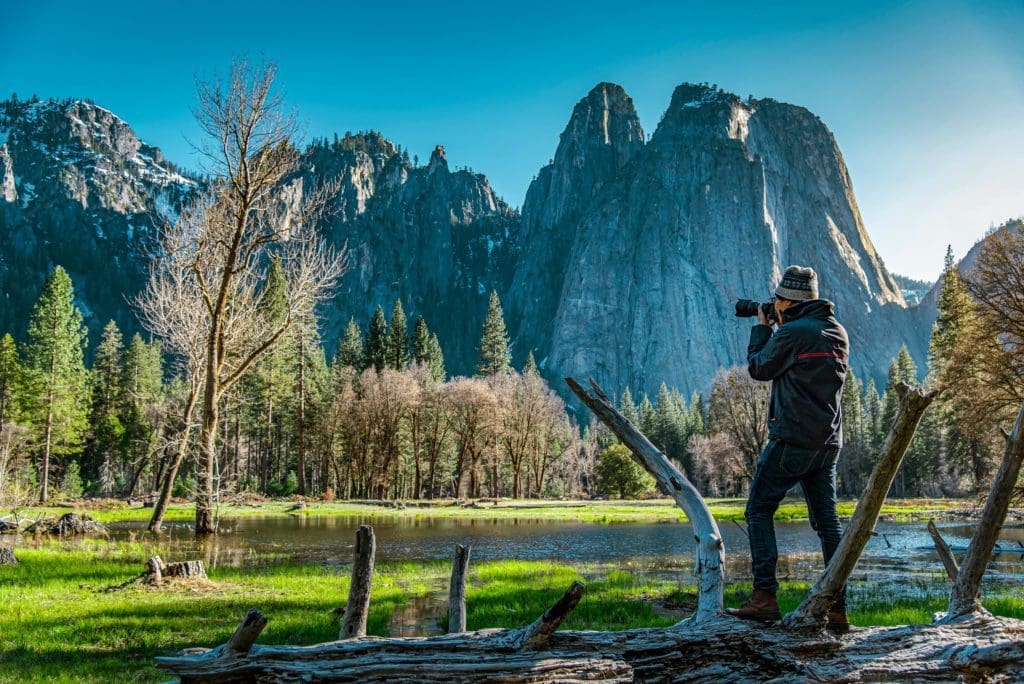
Photographer taking photo of Cathedral Rock landscape in Yosemite National Park.
Winter In Yosemite
The park takes on a whole different look during the off-season. Better yet, the crowds die down. You might have to layer more diligently, but weather in the Valley usually stays pretty comfortable. And there’s plenty to keep you busy during the winter, too.
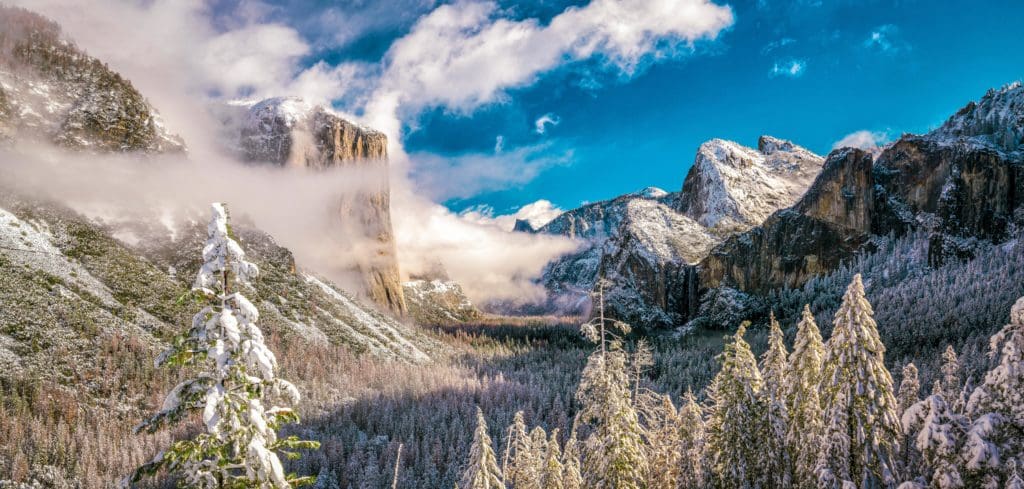
Yosemite National Park in winter.
Resort Skiing at Badger Pass
Believe it or not, Yosemite has its own ski resort with chairlifts and all! There is a free shuttle that runs from the valley to Badger Pass. Lift tickets are just $55 for adults, not a bad deal for skiing the Sierras. Lifts run from 9 AM to 4 PM daily, beginning in January, snowpack permitting.
Backcountry Skiing
In the high country, there’s a ton of backcountry skiing for those willing to tour in. The Glacier Point ski lodge is a convenient launching point for shorter backcountry skiing days. The Yosemite Mountaineering School also leads guided tours using Badger Pass as a launchpad. Other options usually entail winter camping in the backcountry, which requires some permitting and lots of planning. But if you have what it takes, the options are wide open.
Snowshoeing
If you can’t hike it, snowshoe it! Snowshoes are a no-brainer for seeing Yosemite dressed in white. Depending on the weather, you may have to break trail, or if you’re lucky, the path may be stomped in already. Snow can make travel easier in some places, but it can also be dangerous. Be mindful of avalanche terrain and know before you go. That said, there are tons of winter trailheads that grant access to the higher reaches of Yosemite in the winter. You can venture through Crane Flat, or tromp through Mariposa Grove to experience the change that happens when the giant sequoias are covered in snow. The sky’s the limit.
Famous For A Reason
By now you’ve probably gotten the picture. Yosemite is world famous, but not for any single thing. It’s famous for the way it makes you feel when you sit in the middle of it. Its beauty is beyond description, though there are many who try to describe it anyway. It is, as John Muir said, “the grandest of all the special temples of Nature I was ever permitted to enter.” You probably don’t understand what he meant. Not yet, anyway. But trust us, you will.
Enroll With Global Rescue Prior To Embarking On Your Next Adventure.
When a travel emergency arises, traditional travel insurance may not come to your aid, and a medical evacuation can cost up to $300,000.
The cost when you have a Global Rescue membership? $0. That’s why when the unexpected happens, you want the leader in rescue, evacuation and medical advisory behind you. You want Global Rescue.
Popular Articles:
Book an Unforgettable Adventure with REI in Yosemite National Park
Best Places to Stay at Yosemite National Park
These Action-Filled Trips Are Equal Parts Adventure and Relaxation
Adventurer’s Guide to Kings Canyon National Park, California





